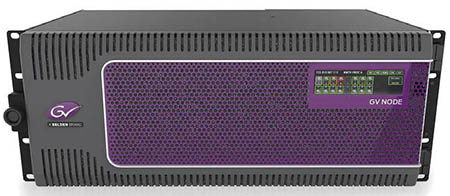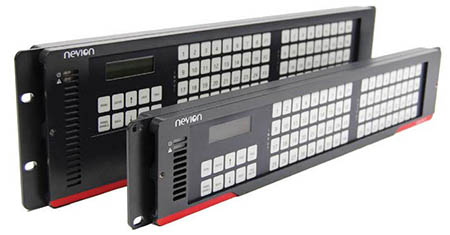Routing Embraces 12G, IP
ALEXANDRIA, VA.—Like much of the equipment, procedures and relationships in the television industry, the role, function and technology of what we call routing switchers is changing. My skill at predicting technology change is probably no better than yours, but routing switcher evolution was one that I was able to bang square on the head.
Years ago, I was the editor of a long-forgotten and short-lived video technology magazine that was in the same publishing family as TV Technology. Exactly 17 years ago, we had an issue that focused on switchers in which I said, “The routing of signals is becoming less a function of ‘switching’ and more like the processing of e-mail or downloading a web file. The day will come when you won’t switch it—you’ll download it.”
Welcome to 2016. Couple that with the seachange from SD technology of 1999 to HD and beyond, and many switchers today bear little resemblance to switchers of a couple decades ago.
That said, there will probably always be a need for small routing switchers to fill specific tasks, such as engineering switchers, monitoring switchers and the like. It’s the big ones—and the ones that handle 4K video—that are dramatically different today.
“Routing switchers are still very relevant for smaller islands and in cases where the majority of I/O is still SDI,” said Mark Hilton, vice president of networking for Grass Valley in Montreal. “For larger operations with, for example, more than 576 inputs, SDI makes less sense given the functionality available with IP solutions.”
HIGHER BANDWIDTH

Grass Valley GV Node Larger applications lean heavily on IP solutions, as IP can handle higher bandwidth today than baseband routing switcher ports. Although 12G-SDI technology (which can handle uncompressed 4K video) is just starting to roll out in the industry, IP technology to handle similar bandwidths is already here.
Get the TV Tech Newsletter
The professional video industry's #1 source for news, trends and product and tech information. Sign up below.
“IP is much more suitable for handling large quantities of 4K signals, as the limitations of switching are not on a port basis, as it is the case on baseband, but on the overall bandwidth that is being switched,” said Svein Håvard Haugen, product manager at Nevion in Sandefjord, Norway. “So where a quad link would occupy a lot of ports or a 12G-SDI interface would require the whole infrastructure to be 12G-SDI, one can fill up 10G links or 40G [IP] links with data both of 4K or 3G signals. Although a 4K signal transported as a quad link into an IP domain would require two 10G links, these links could also contain the HD-SDI or 3GSDI monitoring channels together with audio and data as well. Also, IP allows for easier and cheaper scaling to larger routers when needed.”
Another concern with routing signals at these bandwidths are the cables and connectors needed. At these data rates, cable and connectors have to be manufactured to a higher degree of precision than ever before, and they have to be installed perfectly every time. A pinch in a strand that would cause barely perceptible distortion in an HD-SDI signal will ruin the transmission of a 12G-SDI signal.
4K ROUTING

Nevion Sublime X2 series switcher controls With the high level of interest in 4K, it’s no surprise that this interest spills over into 4K routing and distribution.
“Nevion sees a growing interest in 4K routing from its customers,” Haugen said. “Today the requests are mostly towards quad links, and a lot of the router sales Nevion has today are for 4K quad-link use. In 4K production environments, 4K often lives alongside regular 3G/HD-SDI—this allows one section of the router to be 3G/ HD, while another section is 4K.”
There are some 12G-SDI products out there if you know where to look.
“Utah Scientific built some of the first single-link 12G 4K routers, but it wasn’t as simple as it sounds since the bandwidth is quite a jump from 3G,” said Scott Barella, chief technology officer for Utah Scientific. “We see them going further as SDI matures even more and IP becomes viable with the 25G ports that should start appearing next year in earnest.”
Everyone is looking toward IP for the next generation of signal routing and distribution, so it’s not surprising that the cutting edge of routing switchers today incorporates both baseband and IP signals.
“Grass Valley’s GV Node is designed to work with an IP fabric from vendors such as Cisco and Arista, to provide the I/O and processing necessary as the industry migrates towards IP,” Hilton said. “We also would use modular IP gateway products where they make economic sense in cases where little-to-no processing of the signals is required. This scalable, distributed architecture combining IP COTS core with GVprovided edge devices [provides a] balance between generic IP and value-added broadcast solutions.”
Another example is PESA’s Cheetah Flex IP integrated router. It combines the PESA Blade system with the Cheetah digital video router product line, resulting in a hybrid baseband and IP-based infrastructure that supports up to 4K resolution as well as H.264 streaming video sources.
Utah Scientific addresses the IP/SDI future in its Utah-400 Series 2 router. It handles all existing 3G SDI signals and lets you add IP cards to address the upcoming IP transition. This, coupled with the switcher’s SC-4 control system, gives it the capability to add different levels to the system—including 4K.
Likewise, the Sirius 800 router from SAM (Snell Advanced Media) can handle virtually any industry signal, including SDI, AES, MADI, 4K and IP.
Of course, if you need a small routing switcher to manage a pool of similar signals, there are many available with a range of options and configurations. It used to be that routers were so physically big and expensive that they were used only for the most important centralized switching. Today, they are a small fraction of the size and price, making them perfect for islands of distribution connected to a main control facility. Companies such as Blackmagic Design, For-A, Evertz, Sierra Video and others make such switchers, and have a range of modules and accessories to integrate them into just about any system.
How long will the transition from baseband video switchers to IP routing take? Your guess is as good as mine, but that is clearly the direction that large routing systems are moving.
Bob Kovacs is the former Technology Editor for TV Tech and editor of Government Video. He is a long-time video engineer and writer, who now works as a video producer for a government agency. In 2020, Kovacs won several awards as the editor and co-producer of the short film "Rendezvous."

